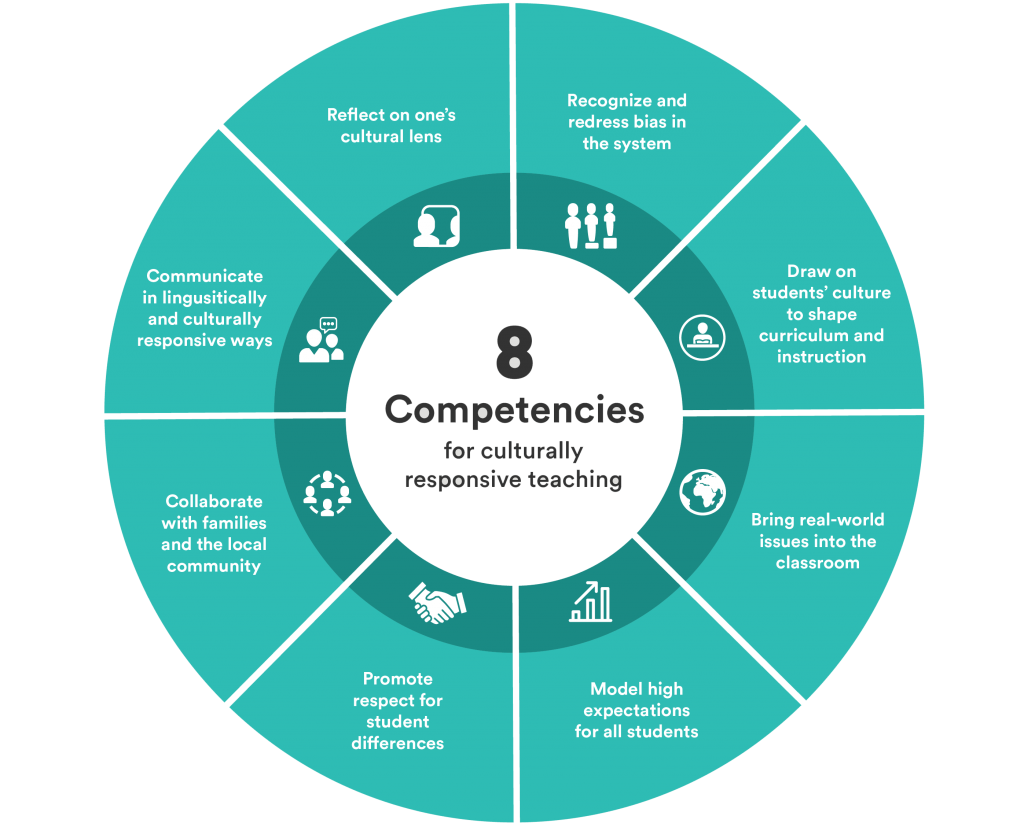Evaluating growth through formative and summative questionnaires.
Learning is not just cerebral.
Story and emotion matters.
Curriculum leaders guide the learning journey with their personalized insights.
It's like reading a book that's filled with awesomely rich interactive multimedia.
Our original content is coupled with the best supportive voices in the field.
Culturally Responsive Education
Course Trailer
Course Overview

Research Based Culturally Responsive Practices
Over the last several years, New America has provided spotlights and recommendations to help policymakers, education leaders, and individual educators foster an aligned and coherent culturally responsive education system.
New America analyzed professional teaching standards in all 50 states to better understand whether states’ expectations for teachers incorporate culturally responsive teaching. To support this analysis, New America identifies eight competencies that clarify what teachers should know and be able to do in light of research on culturally responsive teaching.
Adopting culturally responsive teaching goes beyond celebrating students’ cultural traditions once a year. Educators who practice culturally responsive teaching set rigorous learning objectives for all of their students and they continually build helpful bridges between what students need to learn and their heritage, lived realities, and the issues they care about. In short, culturally responsive teaching is about weaving together rigor and relevance.
Scope & Sequence
8 Competencies for Culturally Responsive Teaching

Reflect on One’s Cultural Lens
Culturally responsive educators routinely reflect on their own life experiences and membership in various identity groups (i.e., those assigned by race, ethnicity, socioeconomic status, sexual orientation, and gender), and they ask themselves how these factors influence their beliefs and actions. They understand that they, like everyone, can unwittingly internalize biases that shape their instruction and their interactions with students, families, and colleagues. They understand that they can unknowingly use stereotypes (overgeneralized beliefs about certain groups) and commit microaggressions (subtle comments or actions that are unintentionally discriminatory) if they are not vigilant about how they think and act.
Therefore, these teachers diligently work to reflect on their unconscious attitudes and develop cultural competency—that is, understanding, sensitivity, and appreciation for the history, values, experiences, and lifestyles of others. Becoming self-aware can be difficult and uncomfortable, particularly for educators who have never explored their identities. However, research shows that actions such as guided reflection, reflective journaling, and group discussions can help teachers overcome those feelings.
Recognize and Redress Bias in the System
Culturally responsive educators understand the difference between bias at the personal level (i.e., racist speech) and bias at the institutional or systemic level (i.e., housing discrimination). They seek to deepen their understanding of how identity markers (i.e., those assigned by race, ethnicity, ability, socioeconomic status, sexual orientation, and gender) influence the educational opportunities that students receive. Sonia Nieto suggests that teachers ask questions like:
- “Where are the best teachers assigned?”
- “Which students take advanced courses?”
- “Where are resources allocated?”
A wide range of resources and professional learning opportunities are now available to help teachers learn more about the ways that institutional racism and other systemic biases disadvantage some groups of students and privilege others. Teachers who take advantage of these resources understand that not all learners are equally rewarded for their hard work. These educators advocate for the disruption of school and district-level practices, policies, and norms that hold students back. Conversely, teachers who are poorly informed about institutional biases may blame learners and perceived cultural deficiencies for academic achievement disparities.
Draw on Students’ Culture to Share Curriculum and Instruction
Central to culturally responsive teaching is the belief that students’ cultural background and existing knowledge can help bridge new learning. Believing this to be true, culturally responsive teachers use cultural scaffolding by providing links between new academic concepts and students’ background knowledge that comes from their families, communities, and lived experiences. They regularly use student input to shape assignments, projects, and assessments.
Although school system leaders traditionally set formal curricula, culturally responsive teachers evaluate the textbooks and instructional resources they use to ensure they do not perpetuate stereotypes or fail to represent certain identity groups. They complement the official curriculum with examples, newspaper clippings, articles, song lyrics, plays, comics, video games, and other resources that reflect experiences, characters, settings, and themes their students can relate to. In addition to providing “mirrors” reflecting students’ own worlds, teachers provide “windows” into the history, traditions, and experiences of other cultures and groups.
Bring Real-World Issues into the Classroom
Culturally responsive teachers address the “so what?” factor of instruction by helping students see how the knowledge and skills they learn in school are valuable to their lives, families, and their communities. They ask:
- “What does this material have to do with your lives?”
- “Does this knowledge connect to an issue you care about?”
- “How can you use this information to take action?”
They regularly assign activities, projects, and assessments that require learners to identify and propose solutions to complex issues, including issues of bias and discrimination. They actively seek input from families, community members, and students when planning learning activities and they ensure learning happens inside and outside of the classroom.
For example, elementary school students might learn about environmental injustice and devise a plan for cleaning up a local river; middle school students might learn to apply math concepts to an analysis of racial inequities in traffic stop data; and high school students might engage in a Socratic seminar to explore solutions to police brutality.
Through rigorous and relevant projects, learners in culturally responsive classrooms build their sense of civic responsibility and learn to see themselves as agents of change.
Model High Expectations for All Students
Culturally responsive educators believe all students are capable of achieving high levels of success. These educators understand that Black, Indigenous, students of color, and other marginalized groups are vulnerable to negative stereotypes about their intelligence, academic ability, and behavior. They understand that these stereotypes can inadvertently influence their pedagogical choices and expectations of students, which in turn influence students’ perceptions about their own abilities.
Culturally responsive educators are vigilant in maintaining their belief that all students can meet high expectations if given proper support and scaffolds, regardless of their identity or past performance. These teachers do not accept anything less than a high level of success from all of their students and they do not allow students to disengage from learning. Instead, they help students develop high expectations for themselves.
Other research-backed behaviors that teachers use to communicate high expectations include using eye contact and proximity with both high-achieving and struggling learners; deploying language, gestures, and expressions to communicate that students’ opinions are important; and ensuring all students have access to a rigorous core curriculum.
Promote Respect for Students Differences
Culturally responsive teachers foster learning environments that are respectful, inclusive, and affirming. Educators contribute to such environments by modeling how to engage across differences and embodying respect for all forms of diversity. They assess how learners from different backgrounds might experience the environment and encourage students to reflect on their own experience with bias. They help students value their own and others’ cultures and develop a sense of responsibility for addressing prejudice and mistreatment when they encounter it.
Research finds that when students face discrimination, they may develop feelings of frustration, anger, and unworthiness that can result in low achievement, behavioral problems, and leaving school. On the other hand, a caring school community can improve students’ academic performance and sense of belonging in school.
Collaborate with Families and the Local Community
Culturally responsive educators assume that parents are interested in being involved in their children’s education and they remove barriers to family engagement. For example, they are available to meet families at convenient times and locations. They are also mindful of any past trauma families might have around interfacing with school.
Because schools have traditionally privileged the input and collaboration of white, middle-class families, culturally responsive educators aim to develop the trust of families of color and low-income families to ensure they are involved at all levels of their children’s education throughout the year. They continually seek to learn more about the local community and families’ cultures, values, and expectations for their children’s education. Further, they see themselves as members of the community and they collaborate with local agencies and organizations to arrange resources that families need.
Communicate in Linguistically and Culturally Responsive Ways
When educators communicate in culturally and linguistically sensitive ways, students and families feel more welcome and inclined to participate in school. Too often, however, miscommunication can occur between white teachers who value passive and indirect styles of communication and students who come from cultures that prefer active and participatory styles.
The communication styles of Black students, in particular, can too often be misconstrued as adversarial or defiant, which can lead to over-disciplining. Therefore, culturally responsive teachers seek to understand how culture influences communication, both in verbal ways (e.g., the tone of voice, rhythm, and vocabulary used) and nonverbal ways (e.g., the amount of space between speaker and listener, eye contact, body movements, and gestures). They allow students to use their natural ways of talking in the classroom. They also honor and accommodate multilingual students and families, including by advocating for translation services and resources in various languages.
The Problem:Teachers Lack Support
The majority of US states do not provide clear orcomprehensive CRE support for teachers
Our Solution:Online Professional Development
This course offers CRE training directly to educators everywhere
50 States of Researchin Your Hands
New America identifies 8 Culturally Responsive Competenciesthat educators need to know
The FoJ platform creates a timely virtual space for educators to engage in discourse and learning about current and historical social and racial justice issues, tailoring both content and technology to best support educator learning.
Minneapolis Public Schools
Instructors
We partner with the brightest minds in social justice work to bring you original content from the experts.
Contact
Engage with this course & join the Frontlines!
Interested in implementing this professional development course in your classroom, school, or district? Reach out to us!





